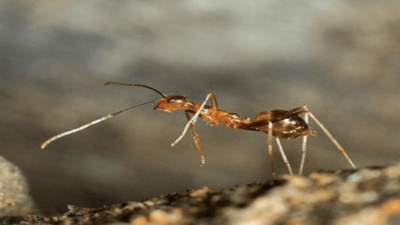Invasive yellow crazy ants present brand new threat to Goa's ecology

A large dose of the ants’ venom could lead to destruction of cells
PANAJI: Hardy, quick growing and able to carve out supercolonies, yellow crazy ants (YCA) are the latest addition to the list of invasive species battering Goa's ecology. Experts say this is bleak news as these ants could cause a wide-ranging impact on man, animals, plants and their food.
Look-alikes of the local weaver ants, these aggressive little ants, which spray formic acid, are injuring domestic animals and causing skin allergies in humans. Supercolonies of these ants, each one harbouring 6,000 to 10,000 individuals and 50 to 300 queens, are also destroying the roots, thereby wiping off crops.
Interestingly, yellow crazy ants are already striking terror in several villages across Tamil Nadu's Dindigul region. Blinding of cattle due to formic acid and migration of some tribals in some pockets of Tamil Nadu due to destruction of crops has been reported.
"This appears to be the first convincing case of the perils of the invasive yellow crazy ant," said Pronoy Baidya, an ecologist with the Arannya Environment Research Organisation. We in Goa are probably headed in the same direction as they are ready invaders of disturbed habitats such as urban areas, forest edges or agricultural fields. These ants have spread across the state,” said Pronoy Baidya.
His paper, related to ecosystem services provided by ants, was published recently in a research journal. For humans, the formic acid concentration in the ant venom of the yellow crazy ants is not potent enough to cause fatality. However, experts say, a high dose of venom resulting from a huge number of ant bites could lead to destruction of cells, especially red blood cells, and also give rise to paralytic effect.
“Those allergic to ant bites could end up in an immediate hypersensitive reaction called anaphylaxis. Life-threatening reactions like difficulty in breathing or extreme drop in blood pressure could result in a sequel to anaphylaxis called anaphylactic shock” said microbiologist Dilecta D’Costa. The sting of these ants causes itchiness and swelling. “Antihistamines such as chlorphenamine can help to reduce swelling, itching or burning sensation.”
Apart from ants, a few exotic fish species brought for pisciculture by private farms have escaped and colonised in natural water bodies. “African catfish, Mozambique tilapia, suckermouth catfish and Pacu or Piaractus brachypormus compete with local species,” said fisheries scientist at the Indian Council of Agricultural Research (ICAR), Old Goa, G B Sreekanth.
Meanwhile, though lateritic plateaus in Goa and elsewhere are often considered as barren and classified as wastelands, they harbour diverse micro habitats. “This diversity is not easily visible. But these sites are most unique in their ant assemblages,” Baidya said.
Many of these sites are locally threatened by land use conversion that is insensitive to biodiversity. “Future development activities have to adopt a proper management plan that utilizes the concepts of land sparing and land sharing to promote heterogeneous landscapes in lateritic plateaus,” Baidya said.
Look-alikes of the local weaver ants, these aggressive little ants, which spray formic acid, are injuring domestic animals and causing skin allergies in humans. Supercolonies of these ants, each one harbouring 6,000 to 10,000 individuals and 50 to 300 queens, are also destroying the roots, thereby wiping off crops.
Interestingly, yellow crazy ants are already striking terror in several villages across Tamil Nadu's Dindigul region. Blinding of cattle due to formic acid and migration of some tribals in some pockets of Tamil Nadu due to destruction of crops has been reported.
"This appears to be the first convincing case of the perils of the invasive yellow crazy ant," said Pronoy Baidya, an ecologist with the Arannya Environment Research Organisation. We in Goa are probably headed in the same direction as they are ready invaders of disturbed habitats such as urban areas, forest edges or agricultural fields. These ants have spread across the state,” said Pronoy Baidya.
His paper, related to ecosystem services provided by ants, was published recently in a research journal. For humans, the formic acid concentration in the ant venom of the yellow crazy ants is not potent enough to cause fatality. However, experts say, a high dose of venom resulting from a huge number of ant bites could lead to destruction of cells, especially red blood cells, and also give rise to paralytic effect.
“Those allergic to ant bites could end up in an immediate hypersensitive reaction called anaphylaxis. Life-threatening reactions like difficulty in breathing or extreme drop in blood pressure could result in a sequel to anaphylaxis called anaphylactic shock” said microbiologist Dilecta D’Costa. The sting of these ants causes itchiness and swelling. “Antihistamines such as chlorphenamine can help to reduce swelling, itching or burning sensation.”
Apart from ants, a few exotic fish species brought for pisciculture by private farms have escaped and colonised in natural water bodies. “African catfish, Mozambique tilapia, suckermouth catfish and Pacu or Piaractus brachypormus compete with local species,” said fisheries scientist at the Indian Council of Agricultural Research (ICAR), Old Goa, G B Sreekanth.
Meanwhile, though lateritic plateaus in Goa and elsewhere are often considered as barren and classified as wastelands, they harbour diverse micro habitats. “This diversity is not easily visible. But these sites are most unique in their ant assemblages,” Baidya said.
Many of these sites are locally threatened by land use conversion that is insensitive to biodiversity. “Future development activities have to adopt a proper management plan that utilizes the concepts of land sparing and land sharing to promote heterogeneous landscapes in lateritic plateaus,” Baidya said.
FOLLOW US ON SOCIAL MEDIA
FacebookTwitterInstagramKOO APPYOUTUBE
Start a Conversation
end of article









